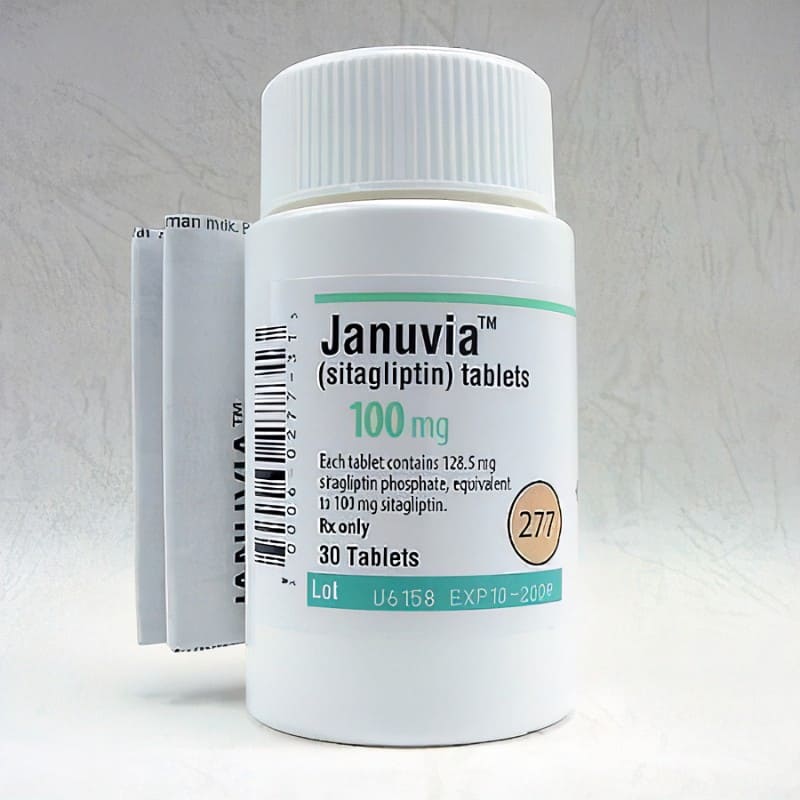Sitagliptin is a medication that is only available with a physician’s prescription. It is available in the form of a tablet for oral administration. The brand-name medication Januvia contains sitagliptin oral tablet. There is no generic version available. Sitagliptin is sometimes used in combination with other medications. This may necessitate the use of additional medications.
Sitagliptin uses
Sitagliptin is used in persons with type 2 diabetes mellitus in conjunction with diet and exercise to enhance blood sugar management. Sitagliptin is not indicated for the treatment of type 1 diabetes mellitus.
Mechanism of action
Sitagliptin is an antihyperglycemic drug in the gliptin class. It works by inhibiting dipeptidyl peptidase-4 (DPP-4), an enzyme responsible for the degradation and inactivation of glucagon-like peptide-1 (GLP-1).
Dosage
This article discusses typical Sitagliptin dose directions issued by the manufacturer of the medication.
In the treatment of type 2 diabetes: Sitagliptin is recommended at a dose of 100 mg once daily for the treatment of type 2 diabetes. Sitagliptin has a maximum dose of 100 mg, so your dosage will not be increased. Sitagliptin should be used in conjunction with physical activity and a healthy diet.
Administration
Take this medication by mouth with or without food, usually once daily, as directed by your doctor. Doses are determined by your medical history, kidney function, and response to treatment. Take this medication on a consistent basis to maximize its effectiveness. Take it at the same time each day to aid in memory. Adhere strictly to the medication treatment plan, meal plan, and exercise program recommended by your doctor.
Sitagliptin side effects
Side effects are possible with sitagliptin. Inform your doctor if any of the following symptoms are severe or persistent:
- Nose that is stuffed or runny
- Throat ache
- Headache
- Diarrhea
- Nausea
Certain adverse reactions have the potential to be severe. If you develop any of the following symptoms, immediately discontinue sitagliptin and contact your doctor:
- Fever, nausea, vomiting, loss of appetite, and persistent pain in the upper left or center abdomen that may move to the back.
- Breathlessness, rapid weight gain, or swelling of the feet or ankles are all symptoms of asthma.
- Itchiness, blisters, or peeling of the skin
- Rheumatism
- Rash
- Hives
- Facial and lip edema, tongue enlargement, and throat swelling
- Breathing and swallowing difficulties
Sitagliptin drug interaction
Inform your doctor about all medications you are taking, including prescription and over-the-counter medications, vitamins, and herbal supplements. Inform your doctor in particular if you are currently on digoxin (Lanoxin), insulin, or any other diabetes medications. Your physician may need to adjust your medication dosages or closely monitor you for negative effects.
Precautions/ safety information
Prior to initiating sitagliptin treatment, consult your physician.
- In case of an allergic reaction to sitagliptin or any other medicine, inform your doctor and pharmacist immediately.
- Inform your doctor and pharmacist of all prescription and non-prescription medications, vitamins, nutritional supplements, and herbal products that you are now taking or intend to use. Make certain to include at least one of the following: Digoxin (Lanoxicaps, Lanoxin); insulin; and a number of oral diabetes drugs, including acetohexamide, chlorpropamide (Diabinese), glimepiride (Amaryl), glipizide (Glucotrol, in Metaglip), glyburide (Diabeta, Glycron, Micronase), tolazamide (Tolinase), and tolbutamide. Your physician may need to adjust your prescription dosages or closely monitor you for negative effects.
- Inform your doctor if you consume large amounts of alcohol or have ever consumed large amounts of alcohol, and if you have or have ever had diabetic ketoacidosis (a serious condition that can occur when blood sugar levels are too high), pancreatitis (pancreas swelling), gallstones, high triglyceride (fatty substance) levels in your blood, heart failure, or kidney disease.
- Inform your doctor if you are pregnant, planning to become pregnant, or nursing. Consult your physician if you become pregnant while on sitagliptin.
- Inform your doctor or dentist that you are taking sitagliptin before having surgery, including dental surgery.
- Consult your physician for instructions on what to do if you are injured or develop a fever or infection. These conditions have the potential to have an effect on your blood sugar levels.
- Consult your doctor about the symptoms of high and low blood sugar, as well as additional problems of diabetes, as well as what to do if you get these symptoms.
Storage
Maintain a temperature range of 20-25oC (68-77oF), with deviations to 15-30oC (59-8oF) tolerated.
Contraindications
Hypersensitivity is a well-documented phenomenon.
Drug Abuse’s Effects : None
Pregnancy or lactation
In general, sitagliptin is contraindicated during pregnancy and nursing. Consult your physician; other medications instead of sitagliptin may be available.




